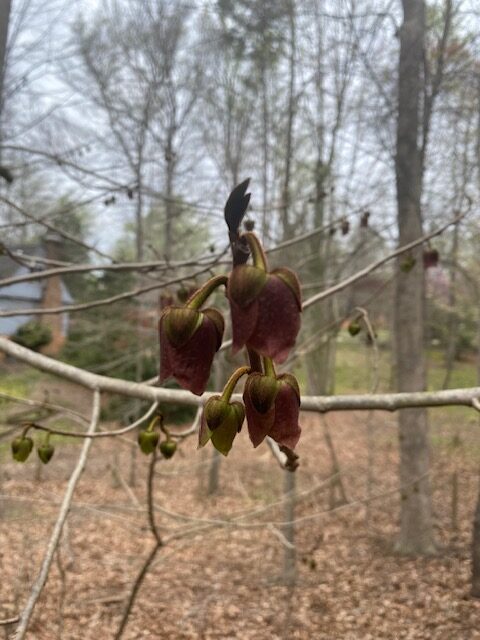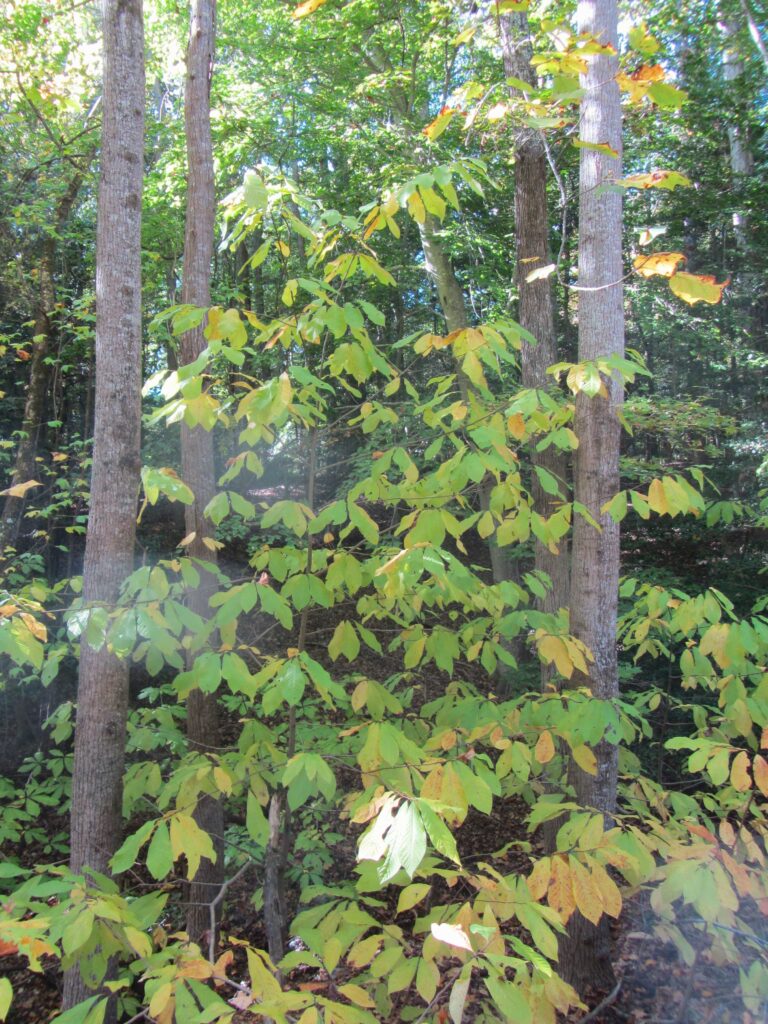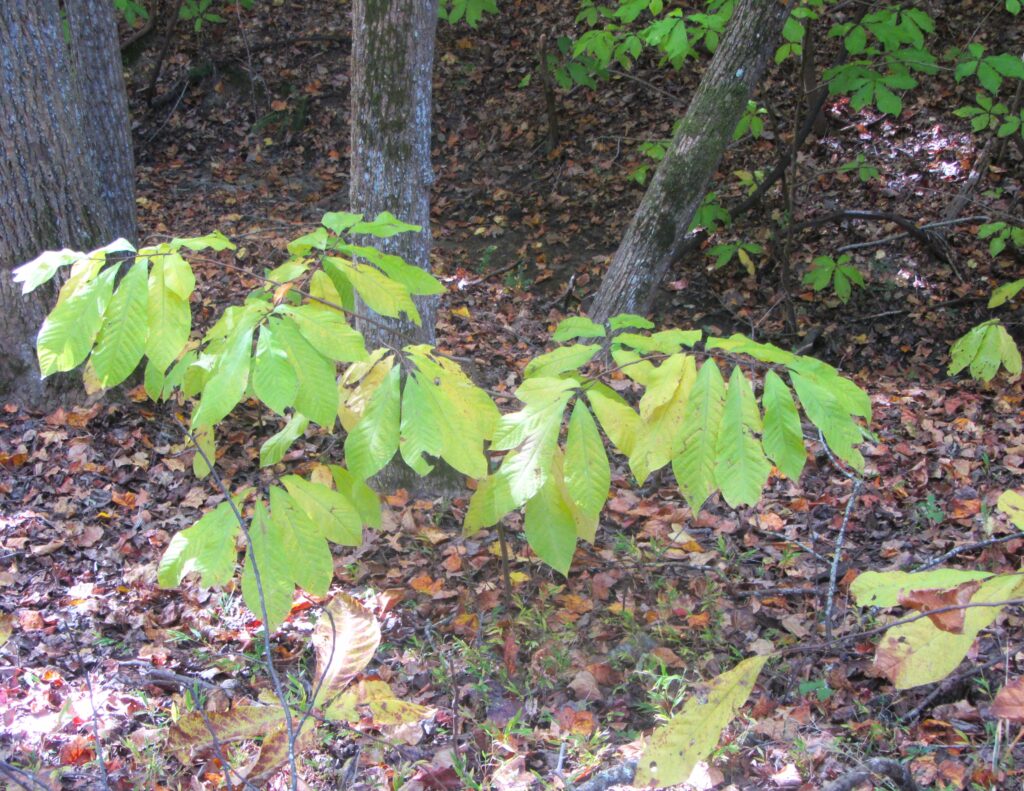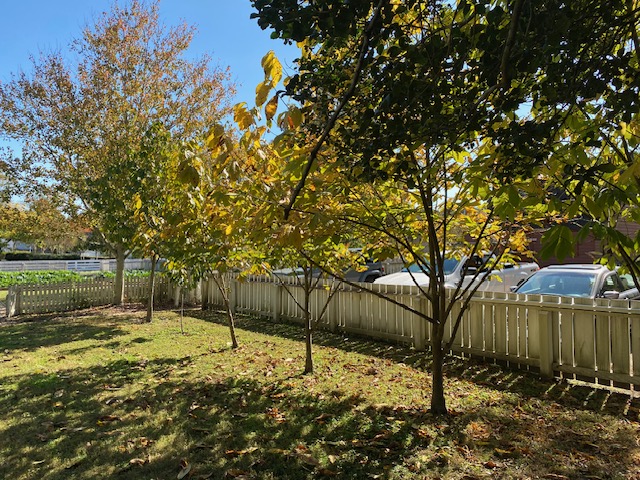Secrets in the Pawpaw Patch, Quick Notes Version

Pawpaw flowers often point downwards, making it even more challenging for insects to pollinate them. It is unlikely they will be pollinated by the wind. Photo courtesy of Rick Brown, taken along the Bassett Trace Trail, Colonial Williamsburg.
Pawpaw Flowers Pollination Challenges
Pawpaw flowers are a dull red to purple color which resembles rotting meat, and they have a putrid odor to attract the flies and beetles that pollinate them , much like native skunk cabbage and jack-in-the pulpit.
Pawpaw’s small flowers have six petals and are rarely larger than a half-dollar. These are ‘perfect’ flowers, having both male, pollen bearing stamens and a female pistil, whose base will develop into the fruit after about five to six months of growth.
The flowers of most pawpaws aren’t self-fertile and require fertilization with a flower from a genetically different plant. Since pawpaw trees grow in patches of clonal duplicates of the same plant, emerging from a single root system, nearby flowers may not pollinate one another.
Pawpaw relies on beetles and flies for pollination, not bees, so pollination can be spotty some years.
If a late freeze kills the flowers, the pawpaw tree has a superpower that apples and other orchard fruits lack. The pawpaw can bloom again in the same spring, with a second flush of flowers.
Growing in the Shade and Shadows
The pawpaw tree is an understory tree native to Eastern North America from southern Canada south to northern Florida and usually grows in the shade and shadows of other, larger trees.
It grows in clearings, along stream banks, on the sides of riparian ravines, and along roadsides.

Asimina triloba grows along the Colonial Parkway. Photo by E. L. McCoy
Pawpaw Leaves
Pawpaw has distinctive large, oblong, simple leaves which look tropical. Leaves may grow to 12” long and 3” wide with acute tips, pointing downwards to shed rain. The leaves smell a bit like green peppers if you crush them slightly.
Read the entire article: Secrets in the Pawpaw Patch
‘Assimina’ Was Cultivated by Native Americans
Pawpaw, Asimina triloba, is indigenous to 26 of our United States. We know from historical records that the first Asimina orchards in North American were cultivated by native Americans, who depended on their fruits for food.
Native Americans valued and cultivated pawpaw trees for many centuries before European colonists learned of them. The genus name, Asimina, sounds like the name given to pawpaws in several native languages. Virginia colonists recorded in 1612 that the Powhatan tribes they encountered called the fruit ‘Assimina.’
The species name, triloba, refers to the three lobes within each fruit, and also to the shape of the pawpaws’ flowers.
The common name, pawpaw, likely comes to us from some Spanish explorers’ confusion between the North American native Asimina fruit and the papayas they had eaten elsewhere on their voyages. Pawpaws were first mentioned in the 1541 records of the Hernando de Soto expedition because they found native communities cultivating these fruits east of the Mississippi River.

Pawpaw fruits grow in clusters. Photo courtesy of Shirley Devan, a Master Naturalist volunteer Trail Guide on Bassett Trace at Colonial Williamsburg.
Eating Pawpaws
Pawpaws are the largest indigenous fruit in North America. They ripen from late August through late September in our area.
According to Kentucky State University, pawpaws have more protein than apples, oranges, or bananas, with measurable amounts of 11 amino acids. They also contain a variety of fatty acids, Vitamins A and C, 8 minerals, and a good amount of fiber.
Only the custardy flesh of the fruit should be eaten as both the peeling and seeds contain acetogenins which cause digestive pain. The fruit is delicious raw.
Both George Washington and Thomas Jefferson enjoyed the fruit and cultivated pawpaw trees on their estates.
The tree’s bark, stems, and leaves are also inedible, though native American medicine people found uses for some parts of the tree other than the fruit pulp.
Colonists at Jamestown would have learned to eat pawpaws as did other colonists along the East Coast of the United States. Lewis and Clark relied on pawpaws, especially when their provisions ran low, during their expedition westwards to explore the Louisiana Purchase in 1804-1806. Adventurers, explorers like Daniel Boone, and soldiers throughout our history have sought out pawpaw trees as the fruits ripen in autumn.
The Most Delicious, Yet Unknown Fruit
Pawpaw fruits have remained something of a secret, rarely found in farmer’s markets and almost never in a grocery store.
Pawpaws ripen quickly and bruise easily. Fruit refrigerated before it is fully ripe will keep several weeks, refrigerated, and can be allowed to finish ripening at room temperature. Just keep in mind that a tree may take 8-10 years after it is planted to become productive.
While other native trees and vegetables were improved, selected, marketed, and put into commercial production long ago, Asimina has proven more elusive. They haven’t been the subject of serious research and improvement until recent decades.
West Virginia native Neal Peterson fell in love with the taste of wild pawpaw in 1975, while he was a graduate student at West Virginia University. He realized that no one else was doing the work to breed a better pawpaw and began searching out heirloom pawpaw varieties known for their high-quality fruit. After many years of searching out pawpaws, collecting seeds from the best fruits, and embarking on his own breeding program, Peterson, also known as ‘The Johnny Appleseed of Pawpaws,’ has trademarked more than 15 pawpaw varieties and licenses them to commercial nurseries to propagate and sell. All of his varieties are named for American rivers along which pawpaw trees grow.
Kentucky State University conducts most current agricultural research on Asimina triloba.
Propagation Challenges
Pawpaw breeding and propagation offers many challenges.
Asimina triloba seeds can be difficult to germinate. Most pawpaw seeds require 110-120 days of cold stratification.
It can take a year or more from harvesting the seeds to tending a seedling.
Seedlings aren’t true to the parent trees and may not bear fruit for the first 8-10 years. Fruits growing on different branches of the same seedling tree may be different from one another.
Stem and root cuttings are difficult to propagate, especially cuttings taken from trees more than a year or so old.
Grafting cuttings onto rootstock is the most reliable way of putting named cultivars of Asimina into production.
There are at least 10 named cultivars marketed for our area, according to NC State University. At least five of those listed were developed by Peterson.
Kentucky State University lists 27 commercially available pawpaw cultivars.
Commercial Production of Pawpaw Fruit
More farmers are experimenting with planting pawpaw orchards of superior cultivars for commercial production.
Many fruit growers have had crops of apples, pears, peaches, and plums damaged or destroyed by everything from late heavy frosts to flooding, hurricanes and tornadoes.
Extreme cold and heat, flood and drought take their toll on agriculture each year, but fruit and nut bearing trees in commercial production have experienced catastrophic losses in recent years due to weather, insect damage, and microbial disease affecting these trees.
Destructive insects and diseases are moving into new territories as the climate warms, but these don’t appear to harm Asimina.
Growers expect that Asimina trees will be resilient and productive and prove to be a good investment.
Growing Asimina Trees
Native Asimina is highly adaptable to growing conditions on many types of soil, including wet soils, from the mountains to the coast, from deep shade to full sun, in Zones 5a-9.
They tolerate occasional drought with their extensive root systems and seem impervious to insect damage and disease.
They prefer acidic, woodland soil, but they will grow in more neutral soil.
Asimina produces its best fruit when cultivated in full sun with genetically different pawpaw trees growing nearby for cross-pollination.
The height and spread of Asima depend on the amount of light and space available to it. Grown in full sun, without competition from other tree species, an Asimina may grow to 30’ tall and wide over a decade or more.
When grown in low light, or on the edge of a shady area, the tree will reach for the sun, sometimes even growing nearly horizontally and not reaching more than 15’ tall.

Young trees begin as suckers growing from the roots of more established trees. A single pawpaw tree can grow into an expanding patch of trees all sharing a common root system. Photo by E. L. McCoy
Practical Uses for Asimina Trees
Asimina trees are an excellent choice for ‘pick-your-own’ orchards. They are a good choice when grown near farmers’ markets where fruit can be sold close to the orchard.
They are also an excellent selection for public parks and community food gardens.
Home growers who have space to allow the trees to sucker and spread into a ‘pawpaw patch’ will also enjoy these beautiful, healthy trees and delicious home-grown fruits.
Many parts of the tree, including its leaves, can be used to make a natural insecticide. This tree’s leaves, bark, seeds, and fruit peelings contain Annonacin, a neurotoxin. This is another reason why pawpaw seeds and peels should not be eaten.
Environmental Benefits of Asimina Trees
Pawpaw is an excellent tree to include in a wildlife garden, or in wilder areas of a large yard, particularly on a property that borders wetlands.
Pawpaw trees serve as a host plant for the Zebra Swallowtail butterfly. But the swallowtail caterpillars do little or no damage to a tree’s leaves and don’t affect fruit production.
These trees are not grazed by deer.
A variety of wildlife are happy to forage fallen, ripe pawpaws as well as their immature fruits. Squirrels often harvest unprotected pawpaws from backyard orchards and wild stands of trees just before the fruits ripen enough for human taste.
Asimina is an excellent choice for riparian restoration projects as its extensive root system helps hold ground against erosion.
Asimina parviflora, the dwarf pawpaw, grows to only 6’-8’ and bears smaller fruits in Zones 7-10. It can grow on sandy soil. Either species will grow well in our area.

The pawpaw orchard of eight trees adjacent to the Catherine Orr garden in Colonial Williamsburg. Photo courtesy of Rick Brown
Pawpaw Trees in Our Region
Pawpaw trees grow wild in the Williamsburg area in ravines, along roadsides like the Colonial Parkway, and in parks and neighborhoods.
You will find pawpaws in cultivation at Colonial Williamsburg at the George Wythe House and a collection of eight trees in the Catherine Orr Garden.
How to Grow Your Own Pawpaw Trees
You can collect pawpaw fruit in autumn and plant those wild seeds.
You will probably harvest better quality fruit if you order a named cultivar from a nursery that specializes in native plants and fruit trees.
Autumn is the best season for planting trees in our area, so they can establish their roots before summer heat and drought.
Pawpaw Renaissance
The pawpaw tree is enjoying a renaissance as we become more aware of our rich heritage of native plants. It is a resilient tree which offers many environmental benefits in addition to its delicious and nutritious fruit.
Local pawpaw enthusiasts have organized pawpaw festivals in recent years to celebrate this delicious native fruit just as they begin to ripen in late August.
There is an annual August pawpaw festival in historic Yorktown sponsored by William and Mary and the Virginia Institute of Marine Science.
There is also an annual August pawpaw festival in Newport News at the historic Endview Plantation.
Both festivals offer plenty of pawpaws, often offer seedling trees, and feature lectures, tours, exhibits, and plenty of excitement.
Read the entire article: Secrets in the Pawpaw Patch
